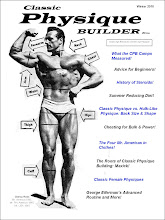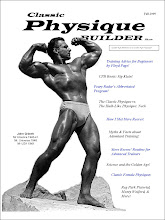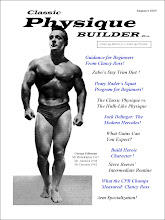
(Photo Above: Jack Delinger, Mr America 1949, on the cover of of the Aug 1955 issue of Muscle Power magazine)
In previous posts, we have talked about the "classic ideal" which is central to classic physique building. But just what is the "classic ideal"?
The "classic physique ideal" refers to the specific characteristics of a classic physique. But the term "classic ideal" is broader than that. It refers to the ethic and values underlying our activity of classic physique building. It is the "classic ideal" which sets "classic physique building" apart from "modern, mainstream bodybuilding."
Perhaps we can best state it this way. The "classic ideal" values:
(1) the physiques of ancient classical and hellenistic Greece
(2) physique building as part of a healthy lifestyle ("physical culture")
(3) the idea of beauty (aesthetics) in the male physique
(4) the goal of pursuing natural, physical perfection (as a balance of muscular size, shape, symmetry, and muscularity)
(5) the development of the mind and character as well as body.
If you examine these components of the "classic ideal," the difference between classic physique building and modern, mainstream bodybuilding quickly becomes clear.
The modern, mainstream bodybuilding world has lost its connection with and affinity for the physiques of ancient Greece. The "champs" of the modern, mainstream bodybuilding world can no longer be looked upon as exemplars of health or a healthy lifestyle. The modern, mainstream bodybuilding world pursues "extreme size and definition" instead of aesthetics in the male (and now even in the female) physique. Their idea of "physical perfection" is no longer natural, but instead it is chemically-based. Finally, there is little to no attention paid to the development of the mind and character and their "champs" do not have the same sense of having to be "good role models."
This is why "classic physique building" and "modern, mainstream bodybuilding" are two different things. So if someone ever asks you "What is the difference between classic physique building and modern bodybuilding?", you can simply say "the classic ideal"!
- CPB
P.S. Note the evidence of the classic ideal in the above cover of Muscle Power magazine from the Golden Age of Classic Physique Building. You won't see that in today's muscle mags!











